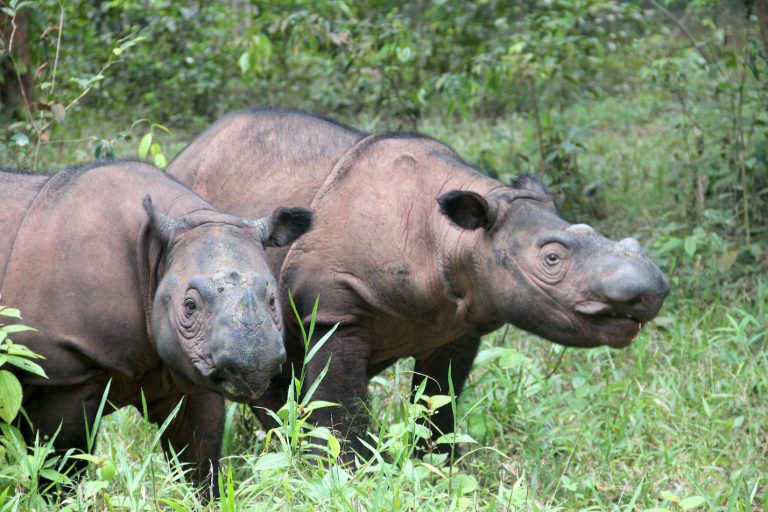The outlook is bleak for Sumatran rhinos. Decades of poaching and habitat loss have precipitated a steep population decline. Once found across Southeast Asia, from the Himalayan foothills to the…
The bison circled four times around the holding pen, before the lead animals took them into the 3,400-hectare (8,500-acre) pasture, their new home on the Rosebud Indian Reservation in the…
By the time the war broke out in Syria, researchers from the International Center for Agricultural Research in the Dry Areas (ICARDA) had already duplicated and safely transported most of…
Experts estimate that nearly 2,000 chimpanzees may be lost to the wildlife trade each year. Once taken from the wild, young chimpanzees that survive the trauma of capture are sold…
When searching for mouse lemurs in Madagascar's forests, scientists seek out their gleaming eyes in the dark. Their eyes are large for an animal about the size of a fist…
As a young boy living on South Dakota’s Rosebud Indian Reservation, Wizipan Little Elk remembers the first time he saw a buffalo herd. The experience ignited a passion, and at…
SIDAMA, Ethiopia — For Lidya Ashango and 14 million other Ethiopians, the false banana plant widely known as enset is a staple food and, on many occasions, a supplementary source…
A mysterious disease is wiping out one of the world’s smallest bats, the aptly named “little brown bat,” which has an extensive range across the United States and Canada. But…
Let’s be honest: many conservationists may start their careers with big ambitions. But as they, and their careers, age, those ambitions — especially in light of the Anthropocene — understandably…
MANILA — There might be more fruit bat species in the Philippines than previously thought, according to a genetic study, underlining the possibility that each individual species might be more…
There’s some uncertainty about his exact age at death, but it’s now been confirmed that “Nandy,” who suffered a crushing blow to his head as a youth, lived to a…
A new subspecies of fin whale, the second-largest species on Earth after the blue whale, has been discovered by scientists in the Pacific Ocean. There are currently three recognized subspecies…
A newly discovered species of grouper almost became someone’s dinner before it could be described to science. Jeff Johnson, an ichthyologist with Australia’s Queensland Museum, had been asked about the…
Think of a reptile that’s been genetically mutated, and Godzilla springs to mind. Or maybe ninja turtles. But the real thing is here, and it’s neither hell-bent on destroying Tokyo…
In September 2014, Nepali zoologist Madhu Chetri asked his professor Morten Odden a strange question during their fieldwork. "Are you tired?" he asked Odden as the duo from the Inland…
Feeding aquatic sponges could provide biologists with unexpected underwater data collection assistance. Sponges (phylum Porifera) are immobile aquatic animals that eat by filtering out food particles from the water around…
Diego Cardeñosa wasn’t expecting any work calls on a Saturday, and certainly not one from the Hong Kong Customs and Excise Department. The urgency of the matter, however, became quickly…
Faster and cheaper Surveying and studying coral takes a lot of work. It’s usually done manually, which requires wet suits and air tanks and SCUBA gear and people. But it’s…
In 1995, there were only 51 kākāpō left on Earth, and it seemed that the giant flightless parrots were headed for extinction. Once abundant in New Zealand, the ground-dwelling kākāpō…
The waters of the eastern Baltic Sea around Finland are home to the flounder, a flatfish with both its eyes on one side of the head that uses its camouflage…
Researchers find that the biome, under assault by soy agribusiness, may need 300 to 3,000 years of focused conservation to recover and maintain its genetic diversity.
The recent plunge in numbers of Grauer's gorillas in the eastern Democratic Republic of Congo (DRC) has lopped off one-fifth of the subspecies’ genetic diversity, leaving it potentially vulnerable to…
Amazonian rivers don’t often drive the creation of new species, but do help maintain distinct populations, according to a study published in the journal Science Advances last month. Amazonian rivers…
For the first time ever, biologists have sequenced the genomes of two tiny ferns, Azolla filiculoides and Salvinia cucullata, and they’ve revealed some interesting secrets. Despite being one of the most…
A fungus that has decimated frog populations around the world could get even deadlier, according to new research. The study found that hybridization of different types of the fungus creates…
The arduous task of assessing animal populations in the wild takes plenty of sweat and tears. Now a group of scientists is adding blood to that mix, in an innovative…
Researchers have identified a genetic analysis technique that pinpoints the harvest location of trees—a breakthrough that could help officials detect illegally traded timber. The multi-national research team tested the potential…
The United States, a major ivory market The sale of ivory across international boundaries has been banned since 1990, when the African elephant was listed among species prohibited for commercial…
The backstory behind the world’s smallest elephants has always been something of a mystery. For one thing, scientists aren’t sure exactly when — and how — Bornean pygmy elephants got…
Is Australia’s Great Barrier Reef losing its male sea turtles? A new study has found that green sea turtle hatchlings in one of the world’s largest colonies are increasingly female,…
Technology is changing how we investigate and protect planet Earth. The increased portability and reduced cost of data collection and synthesis tools, for instance — from visual and acoustic sensors…
Each year, trafficking in wildlife parts earns international crime syndicates some $8 billion to $10 billion. A portable DNA analysis tool can now rapidly identify the species of plant and animal samples found on suspected smugglers.






































































